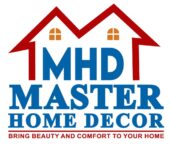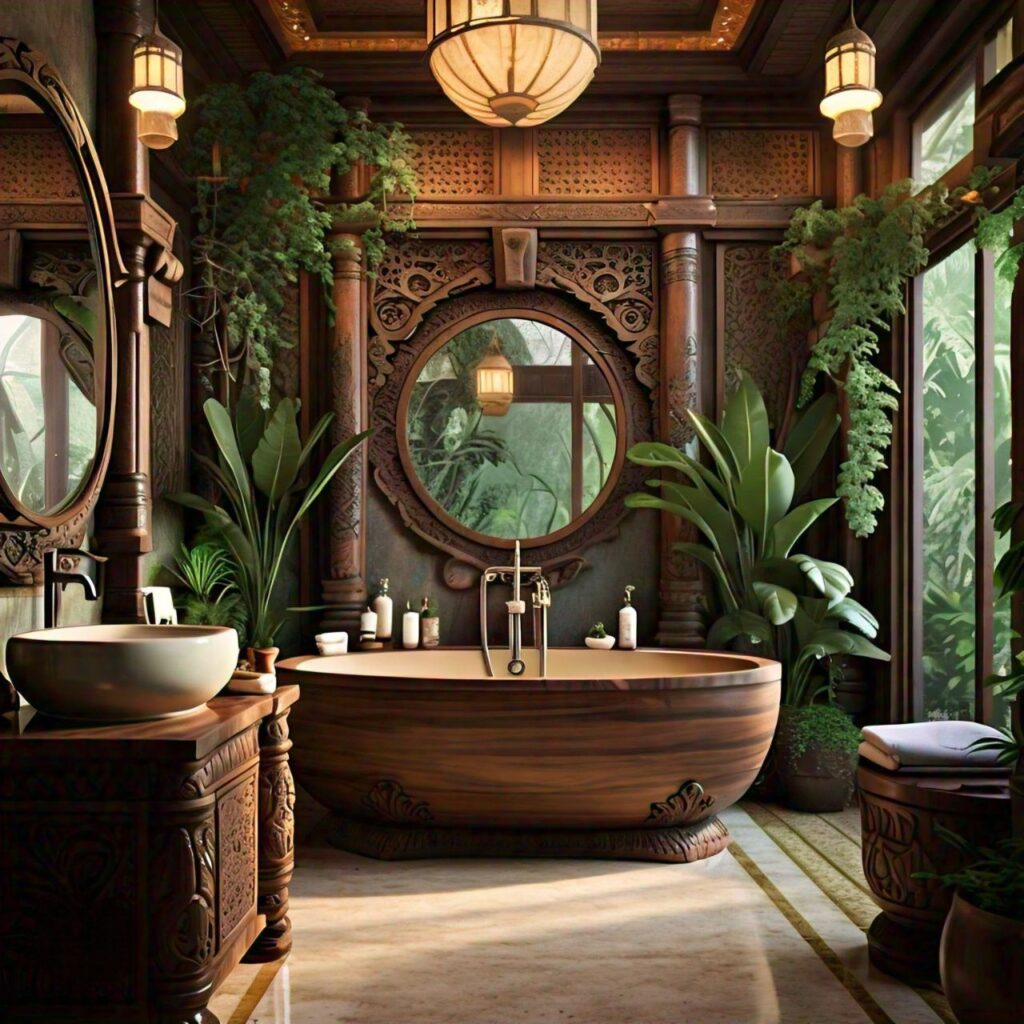Introduction Natural Materials and Plants in Bathroom Design:
When it comes to bathroom design, incorporating natural materials and plants into bathroom remodeling can transform your space into a serene and eco-friendly haven. This approach not only enhances the aesthetic appeal of your bathroom but also brings numerous health and environmental benefits.
These elements aim to create a harmonious, visually appealing, and sustainable restroom space that enhances visual appeal and overall well-being.
In this article, we will discuss the introduction and names of natural materials and plants suitable for bathroom design. Further, we will explore 15 benefits of using natural materials and plants in bathroom design according to different restroom sizes. Let’s explore how these elements can elevate your bathroom design.
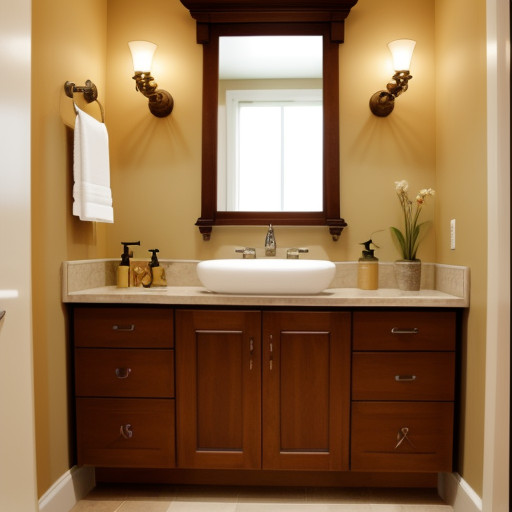
What are the Natural Materials?
Natural materials are those that are minimally processed and sourced from nature. They retain their organic qualities, making them eco-friendly and sustainable choices for interior design.
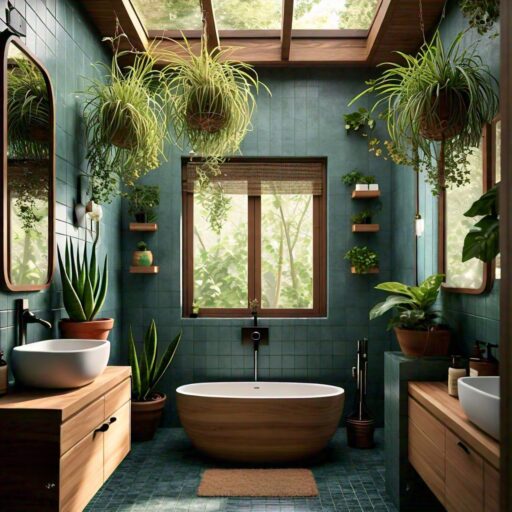
Examples of Natural Materials in Bathrooms:
1. Stone:
Granite: Durable, ideal for countertops and floors.
Marble: Elegant, used for high-end surfaces.
Slate: Textured finish for floors and walls.
2. Wood:
Bamboo: Eco-friendly, water-resistant for cabinets.
Teak: Durable, water-resistant for flooring.
Reclaimed Wood: Rustic charm for cabinetry and accents.
3. Clay:
Terracotta: Warm, rustic look for tiles and accessories.
Ceramic: Versatile for tiles and fixtures.
4. Natural Fibers:
Jute: Ideal for rugs and baskets.
Cotton: Common for towels and bath mats.
Linen: Durable, suitable for towels and accessories.
5. Marble and Onyx:
Luxurious, semi-translucent for countertops.
6. Limestone:
Soft, warm, neutral tone for surfaces.
7. Cork:
Sustainable, water-resistant for flooring.
8. Glass:
Recycled tiles for eco-friendly design.
9. Hemp:
Durable for bath mats and accessories.
10. Rattan:
Decorative baskets and storage solutions.
What are plants in bathrooms?
Plants are living organisms that belong to the kingdom Plantae. These plants play a crucial role in the environment by providing oxygen, improving air quality, and contributing to a relaxing, spa-like atmosphere.
Plants in bathroom design refer to the incorporation of live greenery within the space. These botanicals are specifically chosen for their ability to thrive in the unique conditions of a bathroom, such as high humidity and low light.
Plants can be placed in various locations, such as on countertops, shelves, hanging planters, on a window sill, or on the floor, depending on their size and the available light in the restroom.
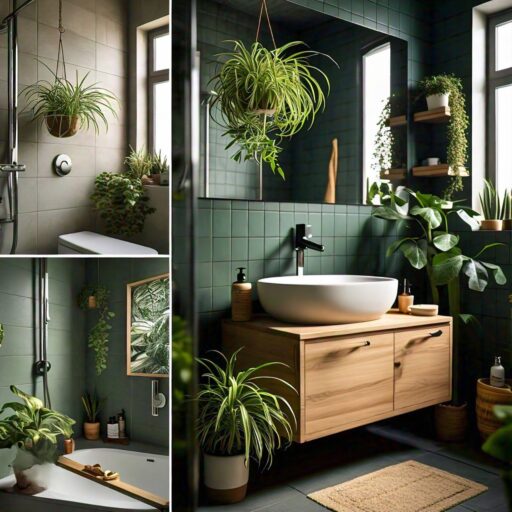
Examples of Plants in Bathrooms:
These plants are all suitable for indoor spaces like bathrooms and can be used in interior design. They are known for their beauty, air-purifying properties, and ability to thrive in specific conditions.
1. Spider Plant: Great for hanging baskets.
2. Aloe Vera: Perfect for placing on countertops.
3. Ferns: Ideal for moist areas.
4. Peace Lily: Excellent for low light.
5. Orchids: Thrive in humidity and add elegance.
6. Snake Plant (Sansevieria): Tolerates low light and high humidity.
7. Pothos: Hardy and low-maintenance for shelves.
8. ZZ Plant (Zamioculcas Zamiifolia): Tolerates low light and infrequent watering.
9. Boston Fern: Loves humidity and indirect light.
10. Philodendron: Thrives in low light and high humidity.
15 Benefits of Using Natural Materials and Plants in Bathroom Design:
Enhance your bathroom with these 15 simple and inspiring ideas. We are sharing easy-to-implement suggestions for incorporating natural materials and plants into your bathroom design, tailored to small, medium, and large spaces. Browse our ideas, choose what suits your style, space, and budget, and explore our included photos for visual inspiration.
With 2-3 stunning images, you’ll see how natural elements can transform your bathroom into a peaceful oasis, making it easy to bring the look to life in your own space.
1. Eco-Friendly and Sustainable Choices:
Natural materials like bamboo and reclaimed wood are eco-friendly and sustainable choices. In small bathrooms, a warm and inviting natural stone wall, reclaimed wood cabinets, and a bamboo mirror frame. The countertop is made of polished granite, and the flooring is crafted from sustainably sourced hardwood. A small potted plant with delicate green leaves sits on the edge of the tub, adding a touch of nature to the space. The overall aesthetic is calm, organic, and deeply rooted in natural beauty.
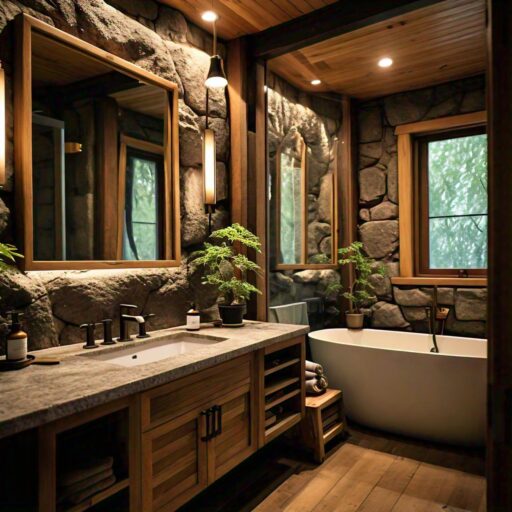
2. Improved Bathroom Air Quality:
Plants like spiders and peace lilies help clean the air, while snake plants handle high humidity. These botanicals remove toxins and improve air quality. Bamboo cabinets, which don’t release harmful chemicals, also support a healthier environment. In small bathrooms, hanging spider plants save space and purify the air. Medium and large bathrooms can use peace lilies on countertops or as floor planters for better air quality.
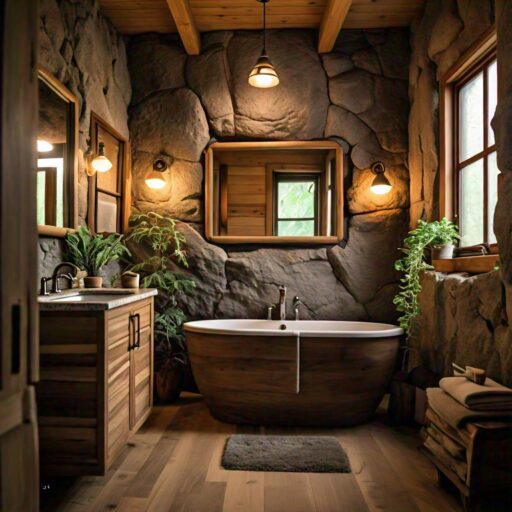
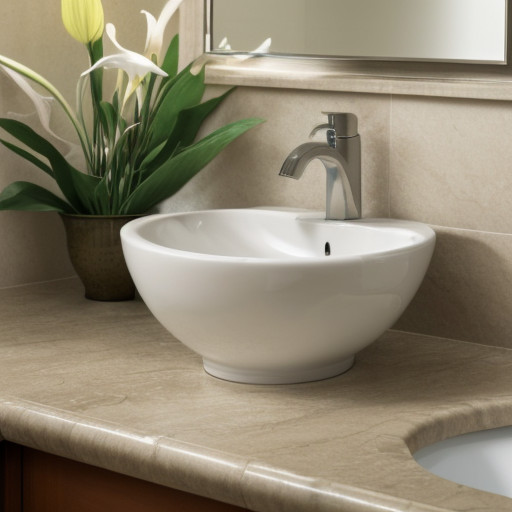

3. Enhancing Aesthetic Bathroom Appeal:
Natural materials like stone and wood make spaces cozy and beautiful. Stone countertops and wood cabinets bring warmth and texture. In small bathrooms, polished stone tiles make the room appear larger. In medium bathrooms, wooden vanities work well, while large bathrooms can feature expansive stone flooring. Adding plants like ferns and pothos creates a calming atmosphere.
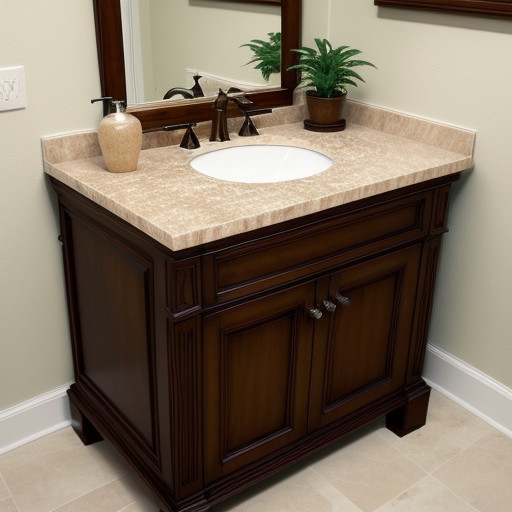
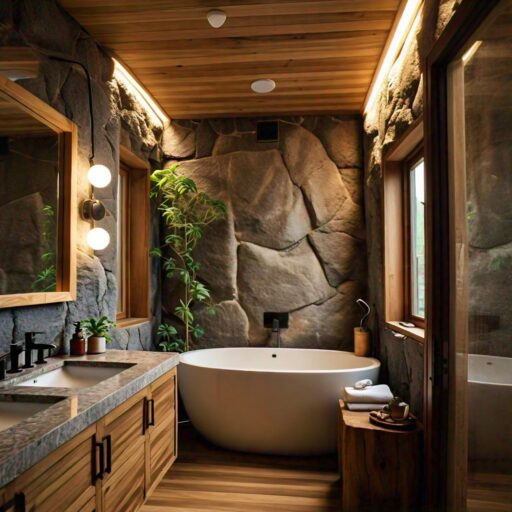
4. Reducing Bathroom User Stress:
Incorporating natural elements can significantly reduce stress. Use eco-friendly materials like bamboo for bathroom storage cabinets and shelves, and cork for flooring. Bring in some greenery, like aloe vera for small bathrooms, and bigger plants for medium, and create a mini garden in large bathrooms to relax and unwind.
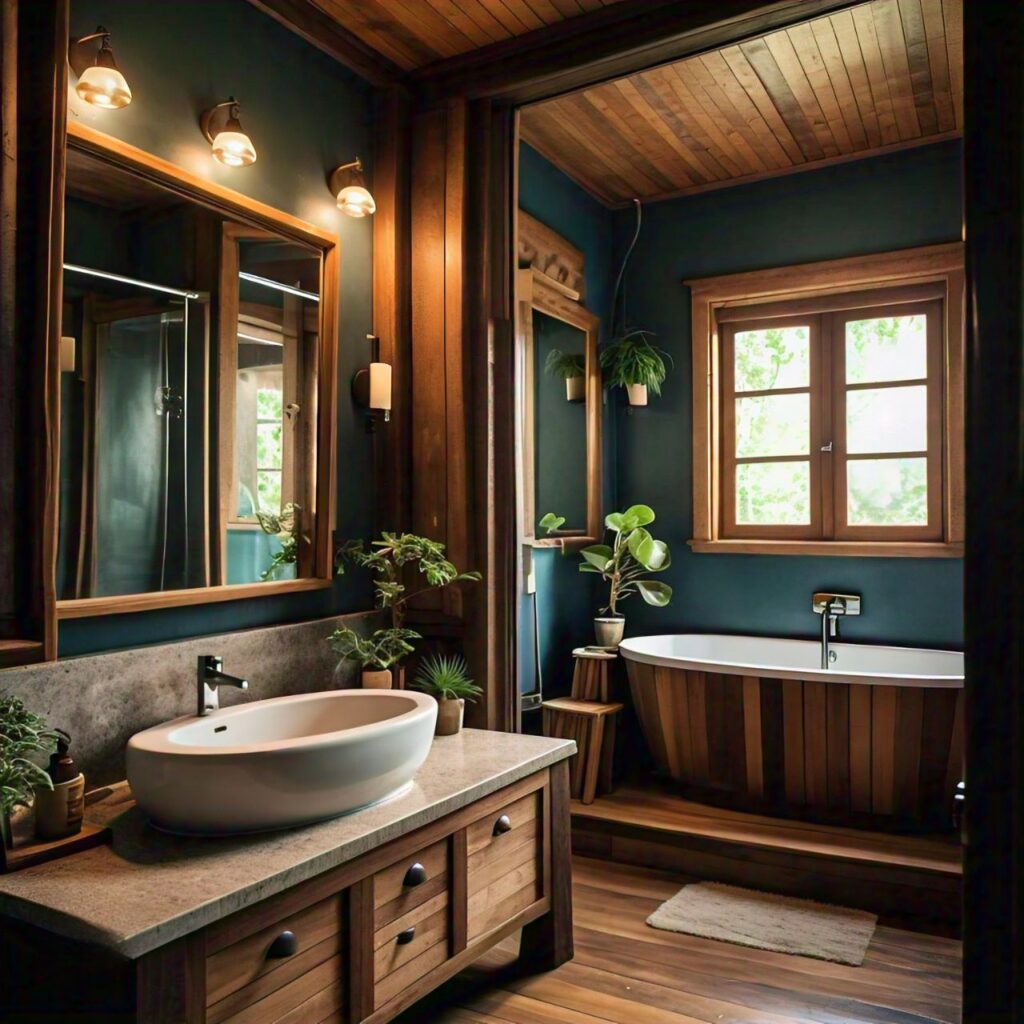
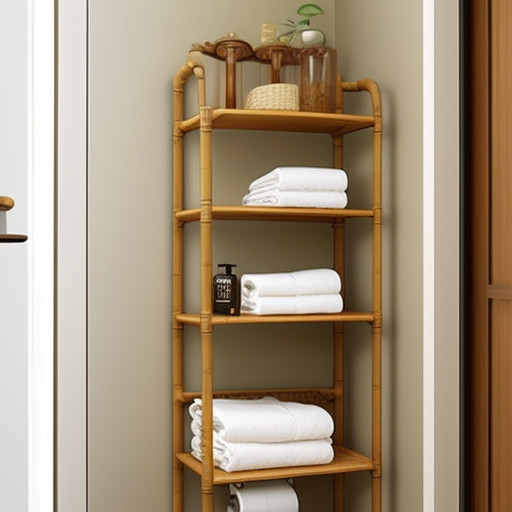
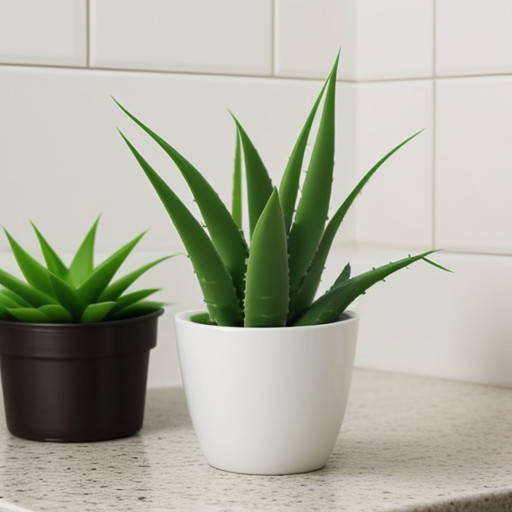
5. Controlling Bathroom Moisture Effectively:
Plants help keep bathrooms fresh by controlling humidity and preventing mold and mildew. They absorb extra moisture and release it back into the air. Choose botanicals that love humidity, like ferns for small bathrooms, ferns and aloe vera for medium-sized bathrooms, and a variety of plants for large bathrooms. Calatheas plants are great for countertops or shelves and help keep the air just right.
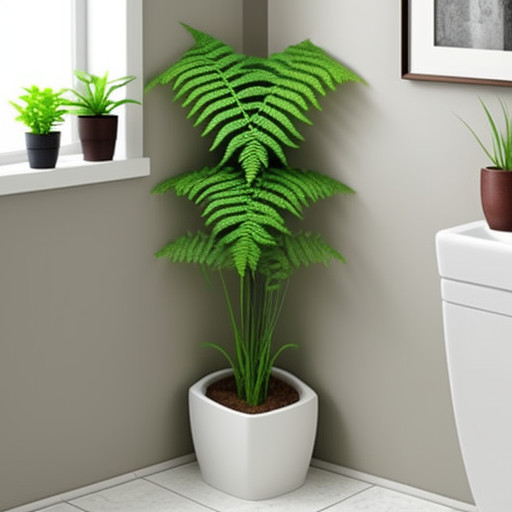

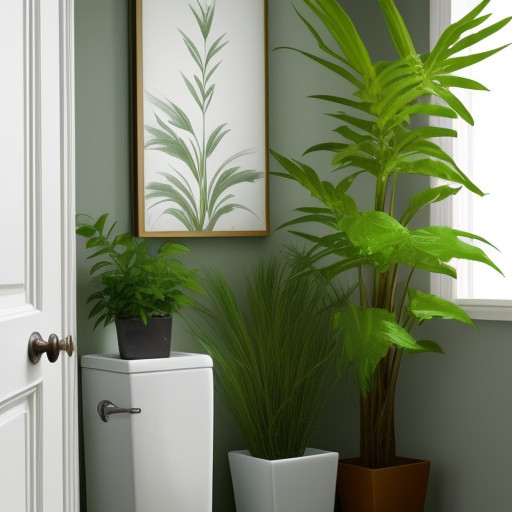
6. Connecting with Nature Inside:
Biophilic design connects people with nature and boosts well-being. In small bathrooms, use natural fiber rugs like jute. Medium restrooms can combine wooden accents with plants. Large bathrooms can become a spa-like retreat with lots of natural elements. Teak wood adds warmth to floors, while reclaimed timber adds charm to bathroom shelves or cabinets. Plants like philodendrons, which thrive in high humidity, add a touch of lush greenery.
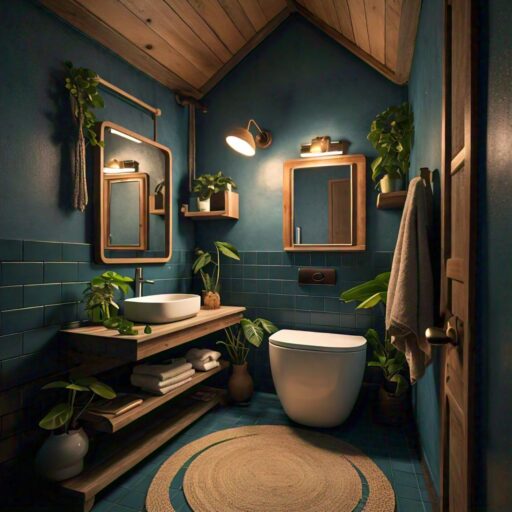
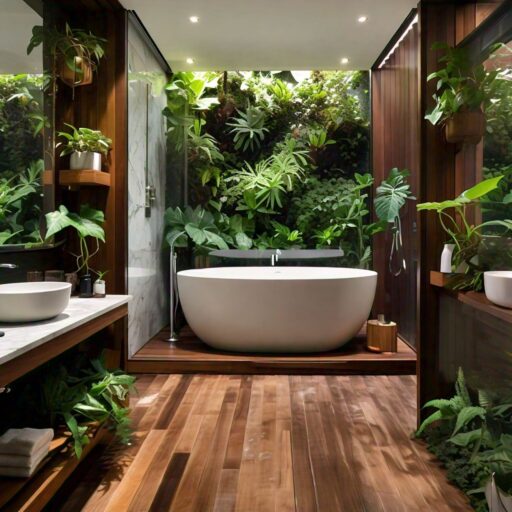
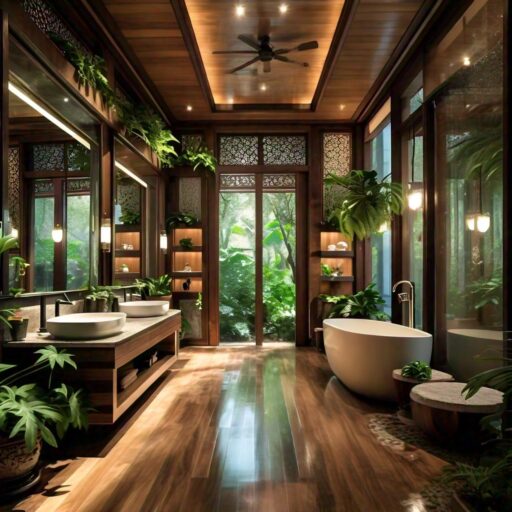
7. Regulating Bathroom Temperature Naturally:
Natural materials like stone and wood regulate temperature, keeping your bathroom cool in summer and warm in winter. Small bathrooms can use stone tiles for better temperature control. Medium restrooms benefit from warm wooden cabinets. Large spaces can combine both for optimal comfort. Limestone adds a soft, warm touch to surfaces. Adding aloe vera on countertops and spider plants in hanging baskets reduces stress, creating a calming atmosphere.

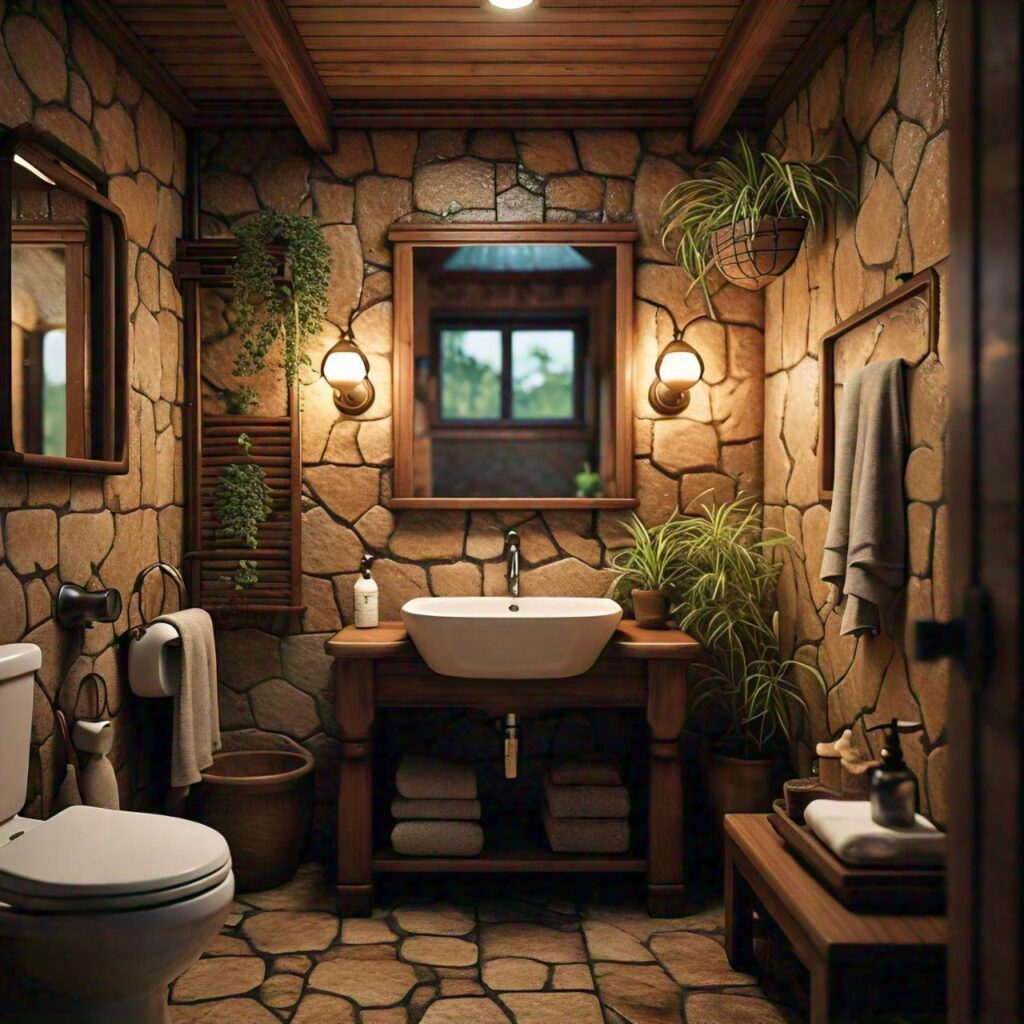
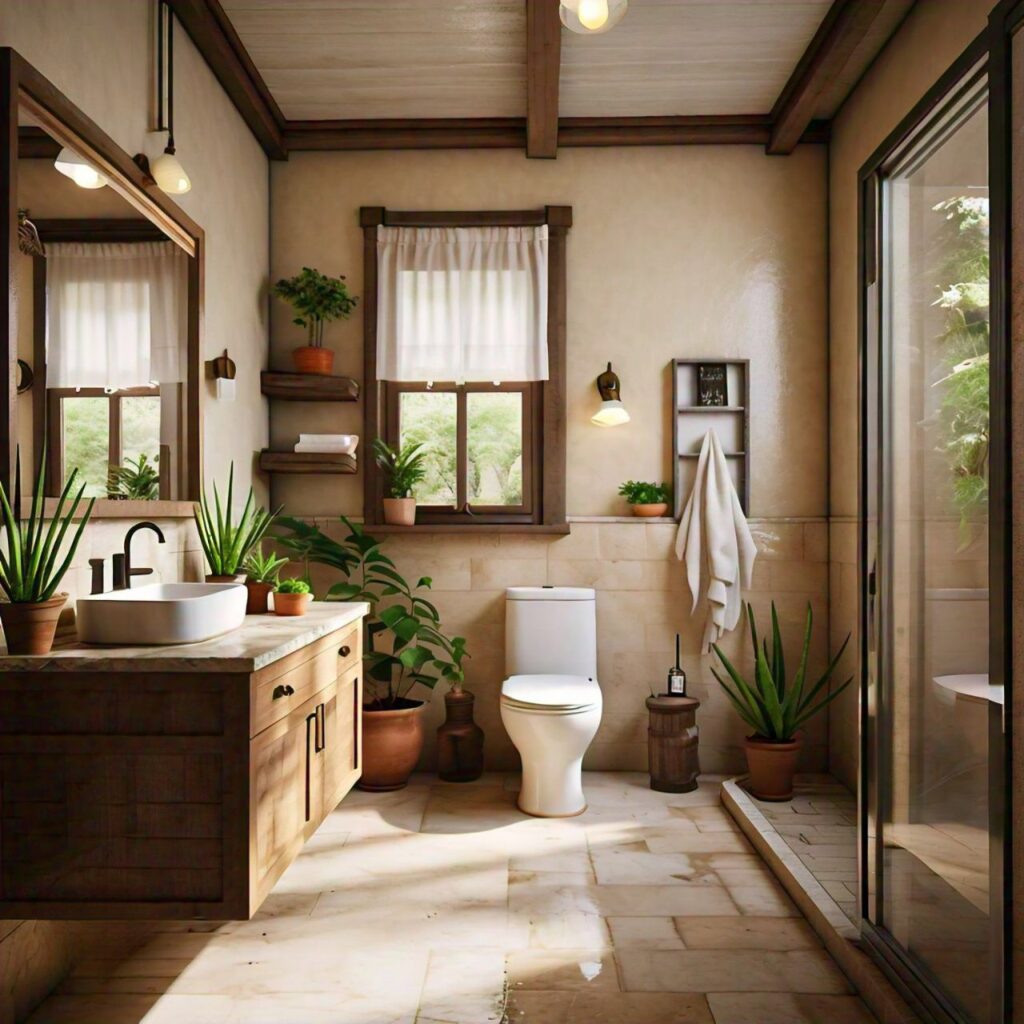
8. Low Maintenance Bathroom Materials:
Incorporating natural materials and plants into your bathroom design can have numerous benefits, including ease of maintenance. Consider using bamboo shelves for small spaces, wooden bathroom vanities for medium-sized bathrooms, and stone floors for large areas, all of which are durable and easy to clean. Adding humidity-loving orchids can purify the air and bring a pop of color without high maintenance, while glass tiles or recycled glass elements can enhance the space while reducing environmental impact.
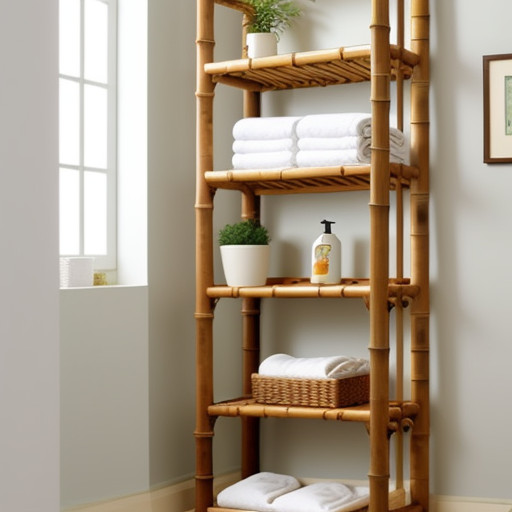
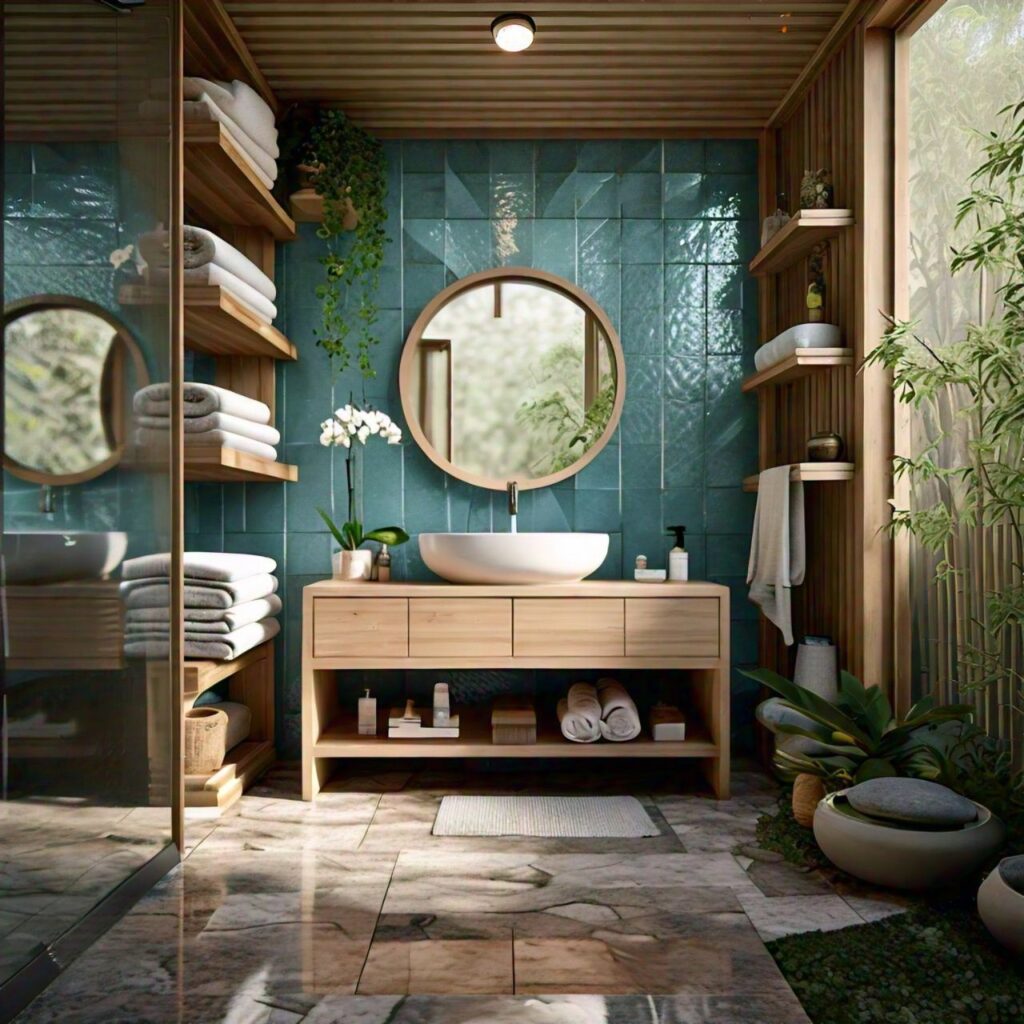
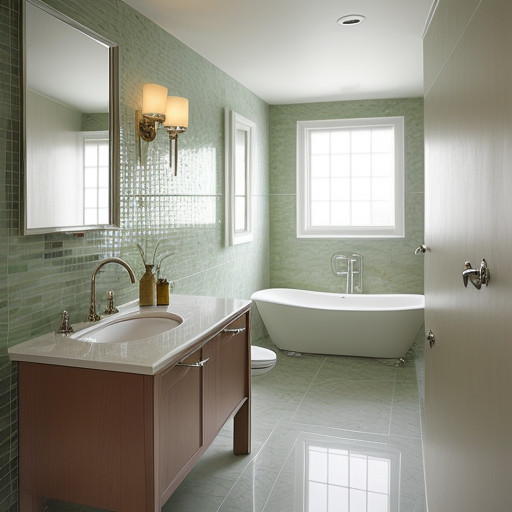
9. Personalized Bathroom Design Options:
Use natural materials and plants in bathroom to make the space truly one-of-a-kind. Wood and stone have their own special characteristics, making each piece unique. Add personal touches like custom bamboo towel racks in small bathrooms, bespoke wooden cabinets in medium-sized restrooms, and unique stone countertops in large spaces. Cork flooring keeps things cozy, and plants like English ivy help keep the temperature just right.
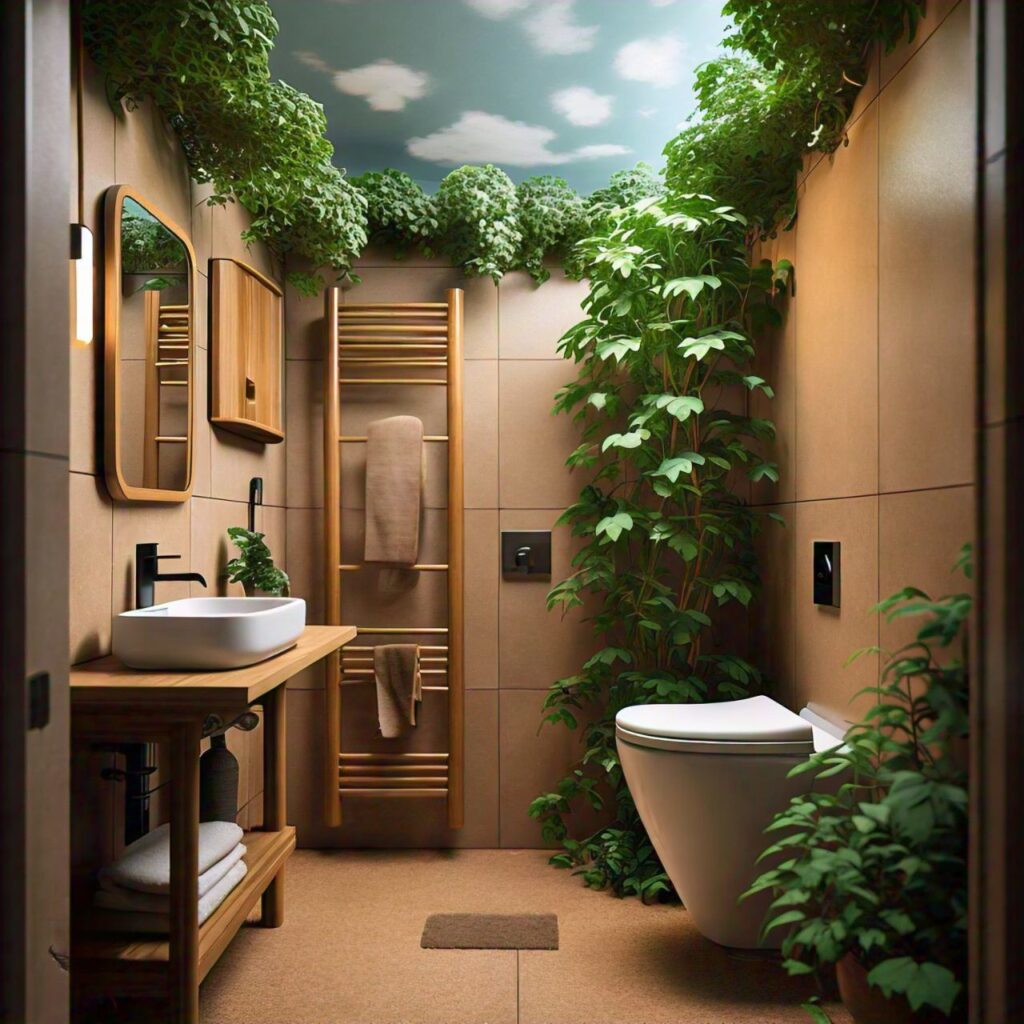
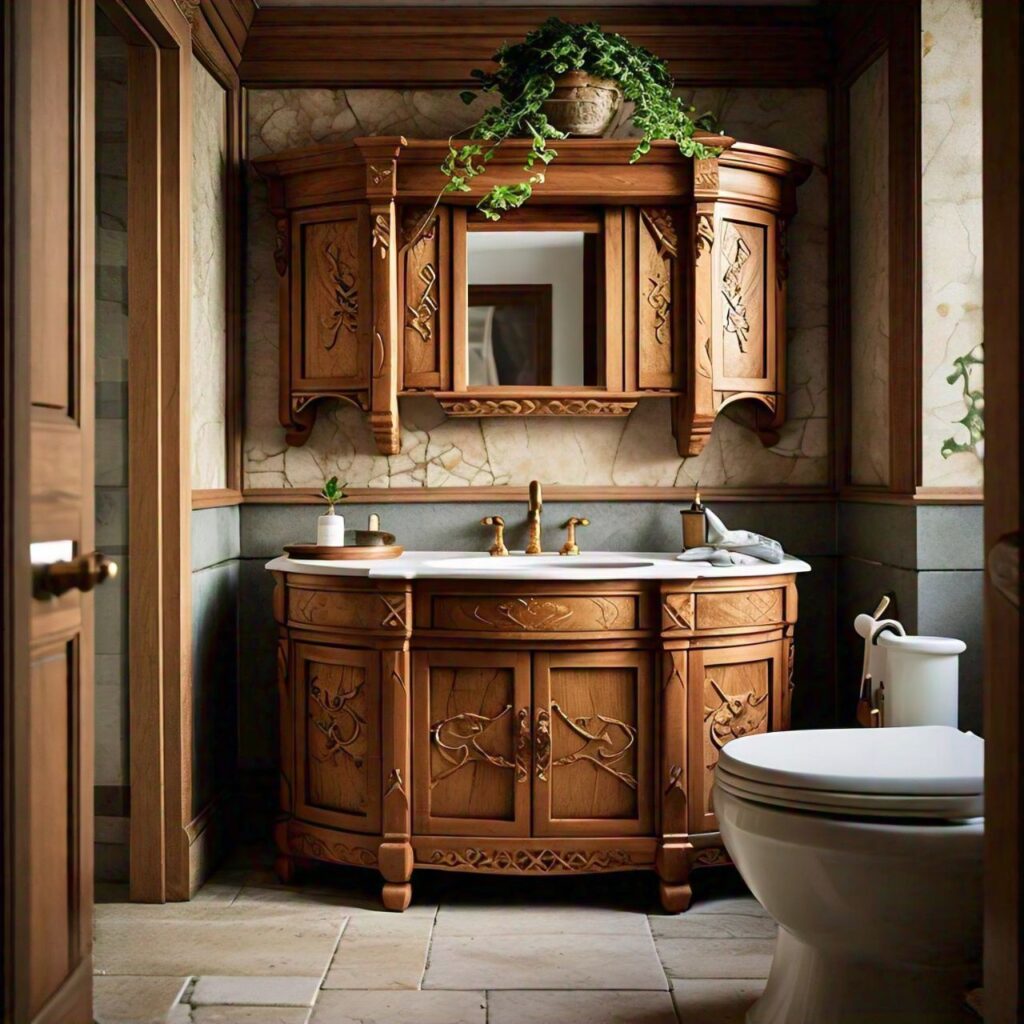
10. Enhancing Bathroom Acoustics Naturally:
Natural materials can make your bathroom a quieter and more peaceful space. Wood and stone surfaces help reduce noise, making it feel more relaxing. Use wooden panels in small bathrooms, stone tiles in medium spaces, and a combination of both in large restrooms for the best results. Jute rugs and baskets also help absorb sound. Adding botanicals like air plants, which don’t need soil, can make your washroom look and feel even more calming.
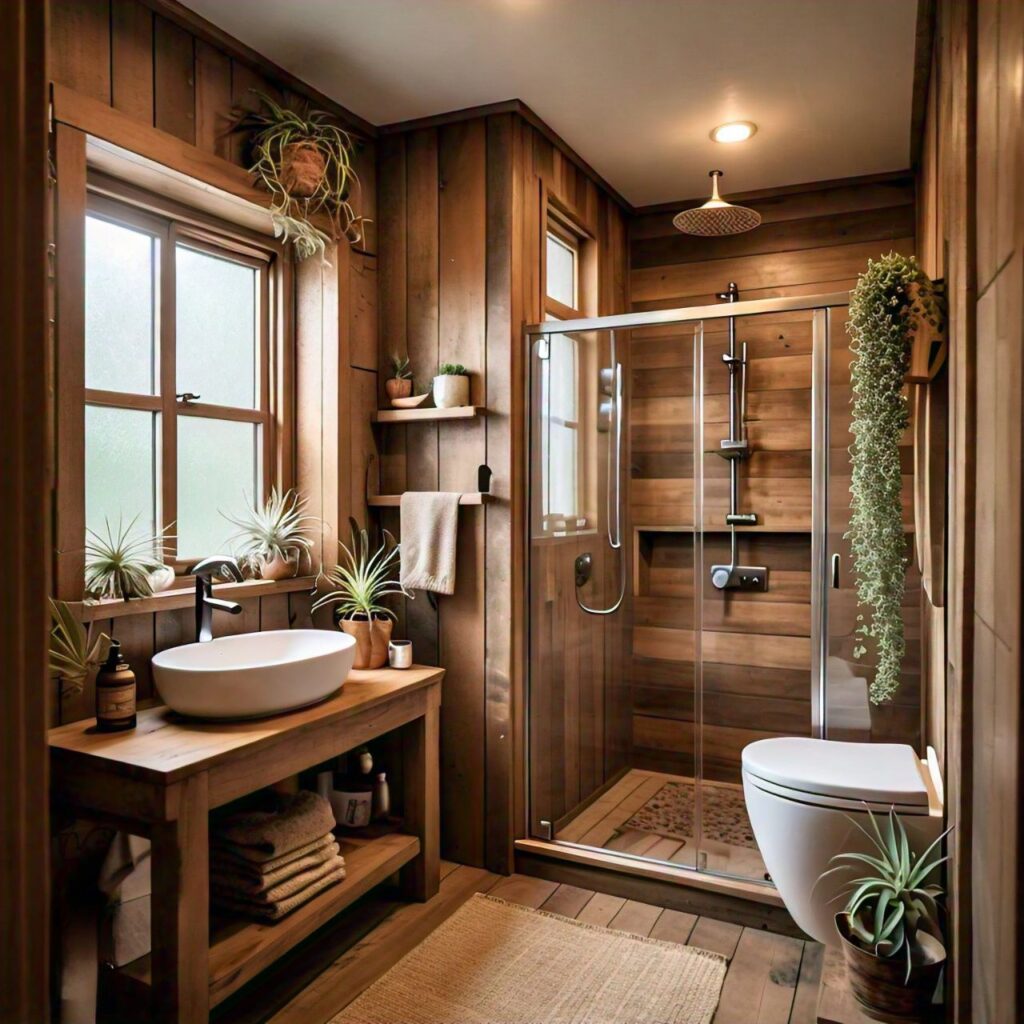
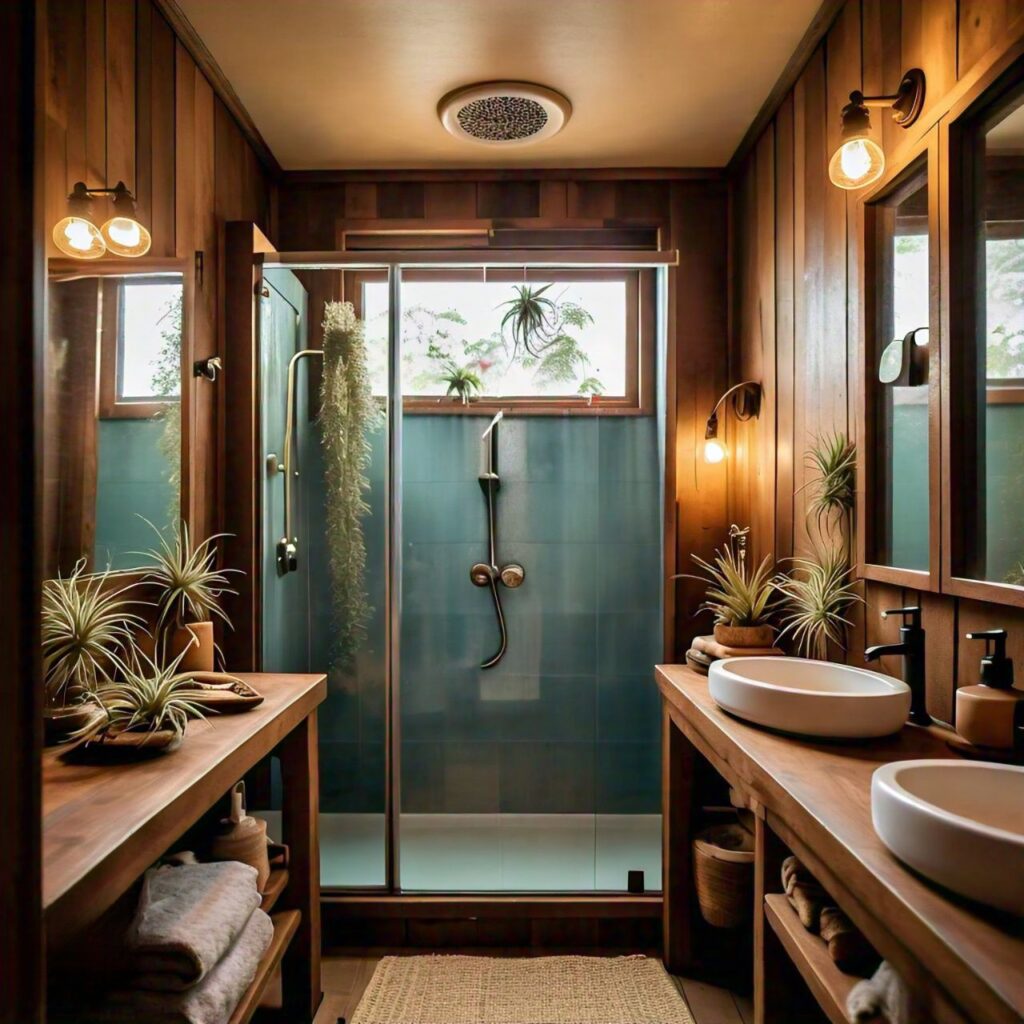
11. Cost-Effective Long-Term Investment:
Natural materials might cost more at first, but they last longer and save you money in the long run. Small bathrooms can start with affordable bamboo accessories. Medium restrooms can invest in quality wooden vanities. Large bathrooms can feature long-lasting stone flooring. Ceramic tiles and fixtures are easy to maintain, and low-maintenance botanicals like pothos and snake plants are perfect for busy homes.
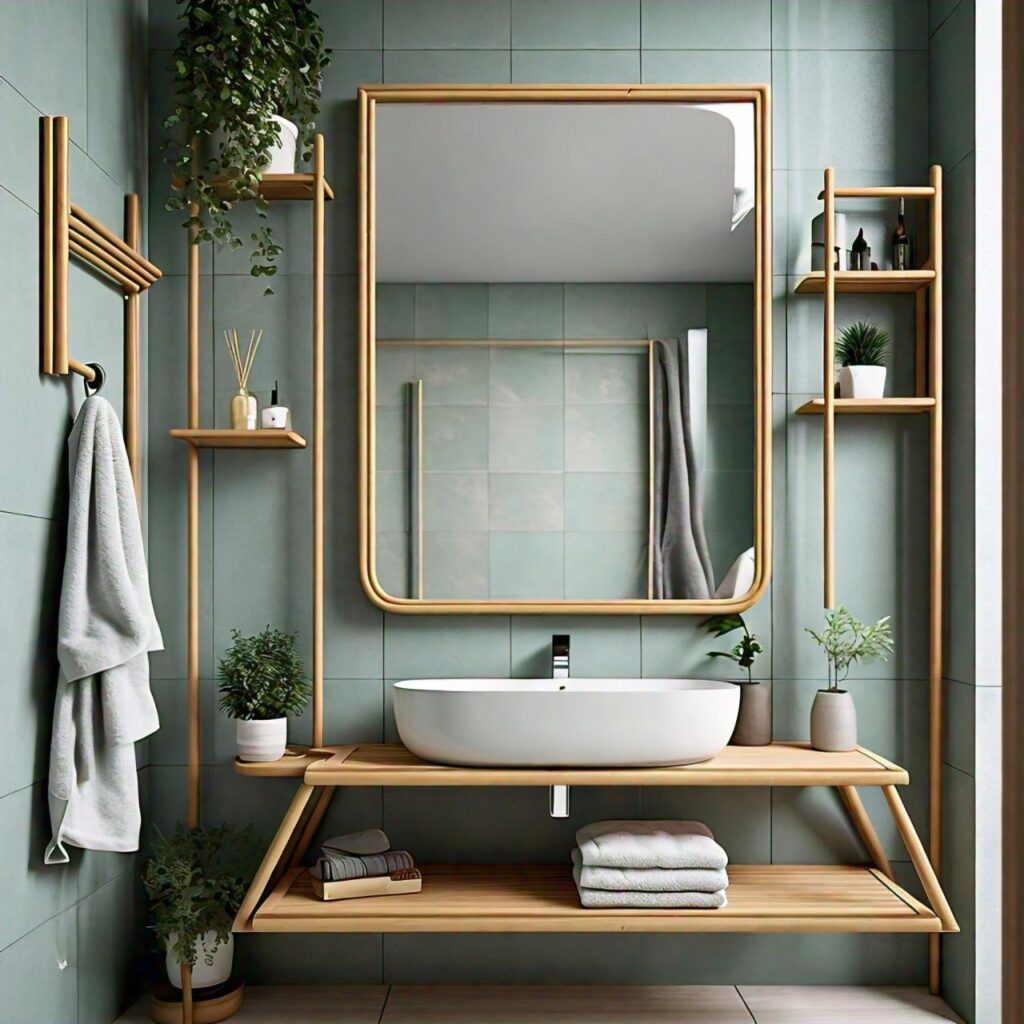
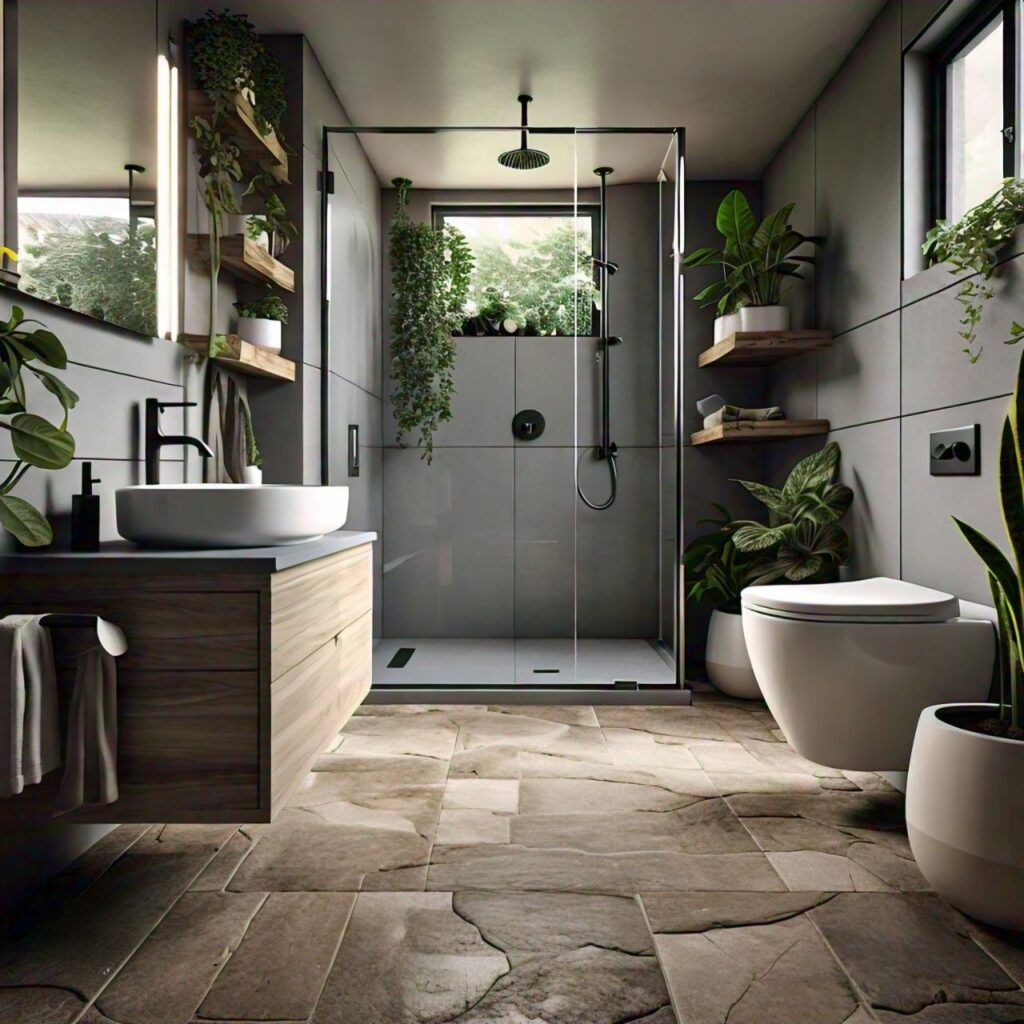
12. Enhancing Lighting with Natural Materials:
Natural materials with reflective surfaces, like polished stone, boost natural light in your bathroom and cut down on artificial lighting. In small bathrooms, polished stone tiles make the space feel bigger. Medium-sized spaces can use light-finished wooden cabinets. Large restrooms can have expansive stone surfaces that spread light throughout the room. Slate adds texture to floors and walls, while Boston ferns in hanging baskets add variety and improve the look.
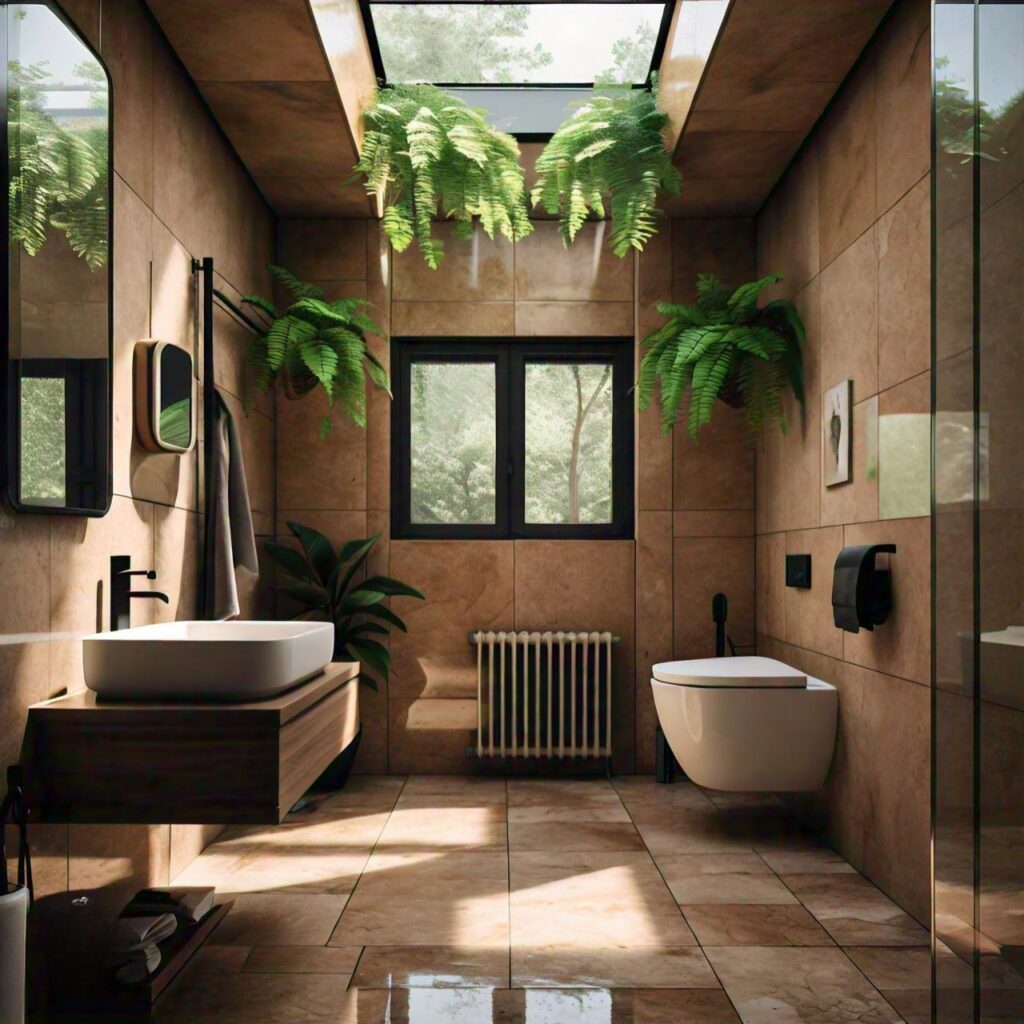
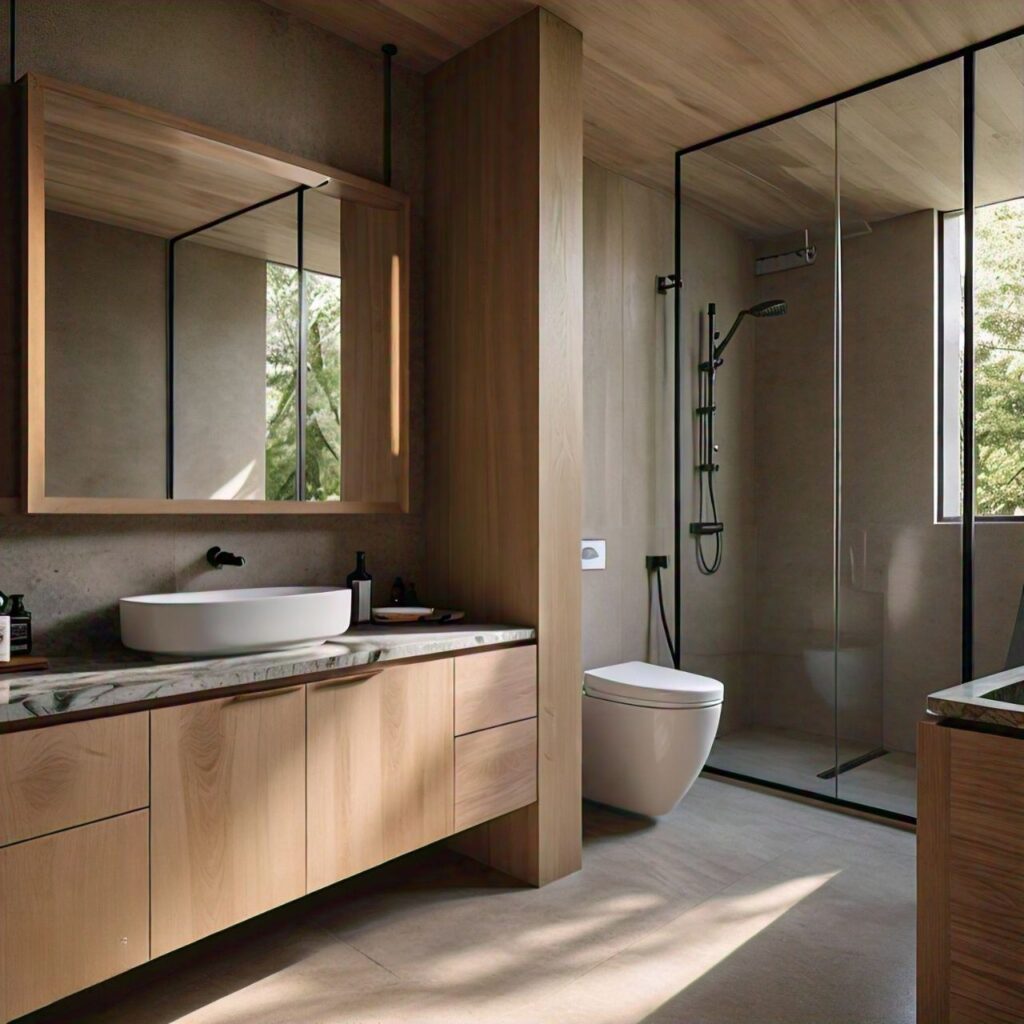
13. Creating a Calming and Peaceful Ambiance:
Transform your bathroom into a serene oasis by incorporating natural materials and plants. Add reclaimed wood and small potted plants to small bathrooms, natural stone and living wall planters to medium bathrooms, and freestanding tubs surrounded by natural wood and floor-standing plants to large bathrooms. Create a peaceful retreat that calms the mind, soothes the body, and uplifts the spirit.
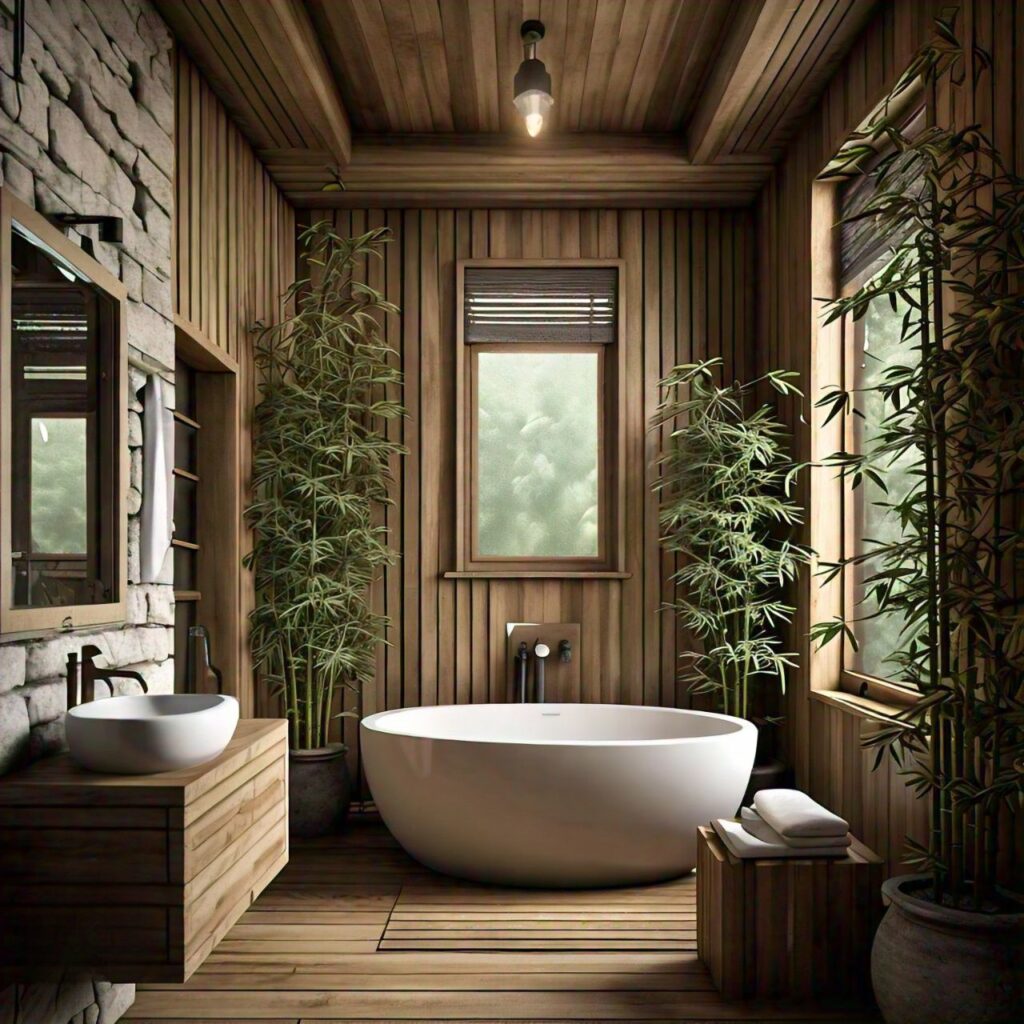
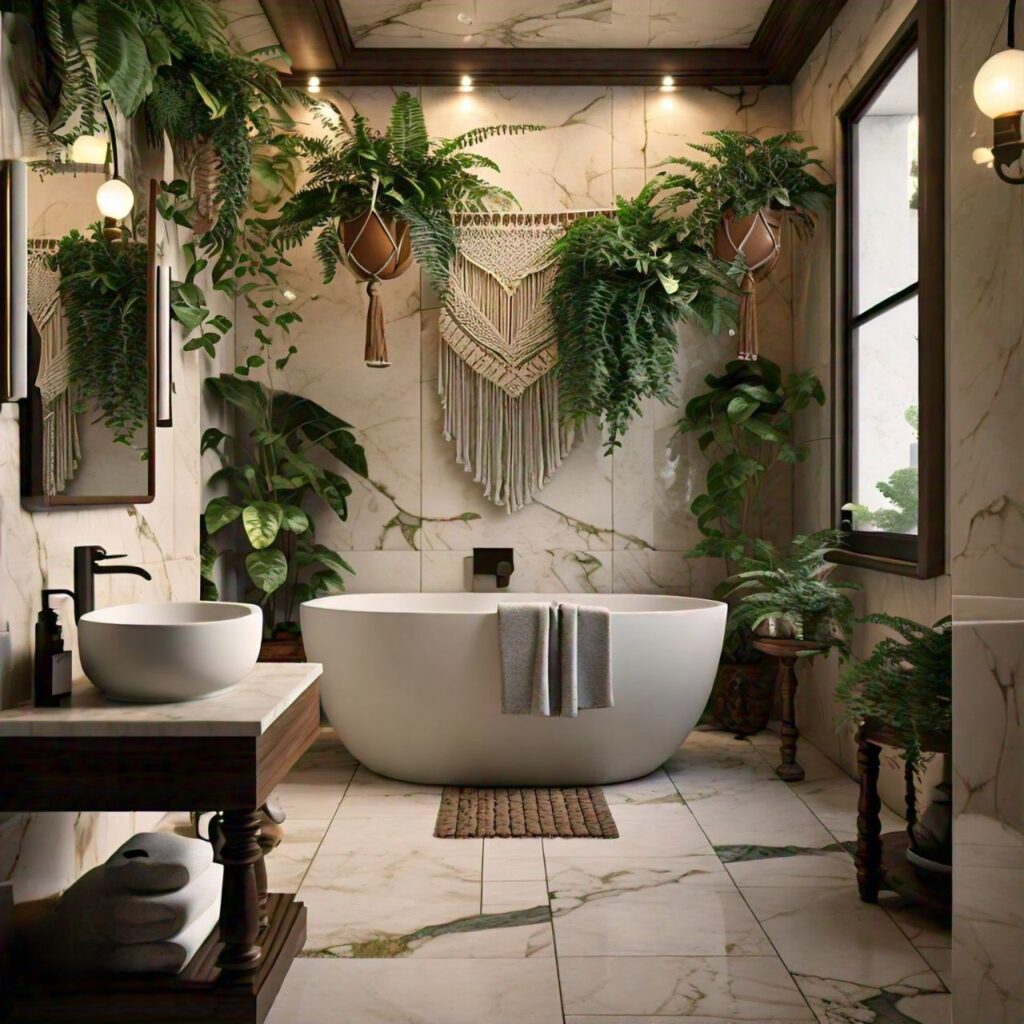
14. Adding Natural Bathroom Fragrance:
Some botanicals, like lavender and eucalyptus, smell great and create a relaxing spa-like atmosphere. Add small pots of lavender to small bathrooms, hang eucalyptus in medium space, and use a variety of fragrant plants in large restrooms. Pair low-maintenance bathroom botanicals like peace lilies with natural towels and accessories for a calming feel. Marble surfaces add a touch of luxury and serenity.
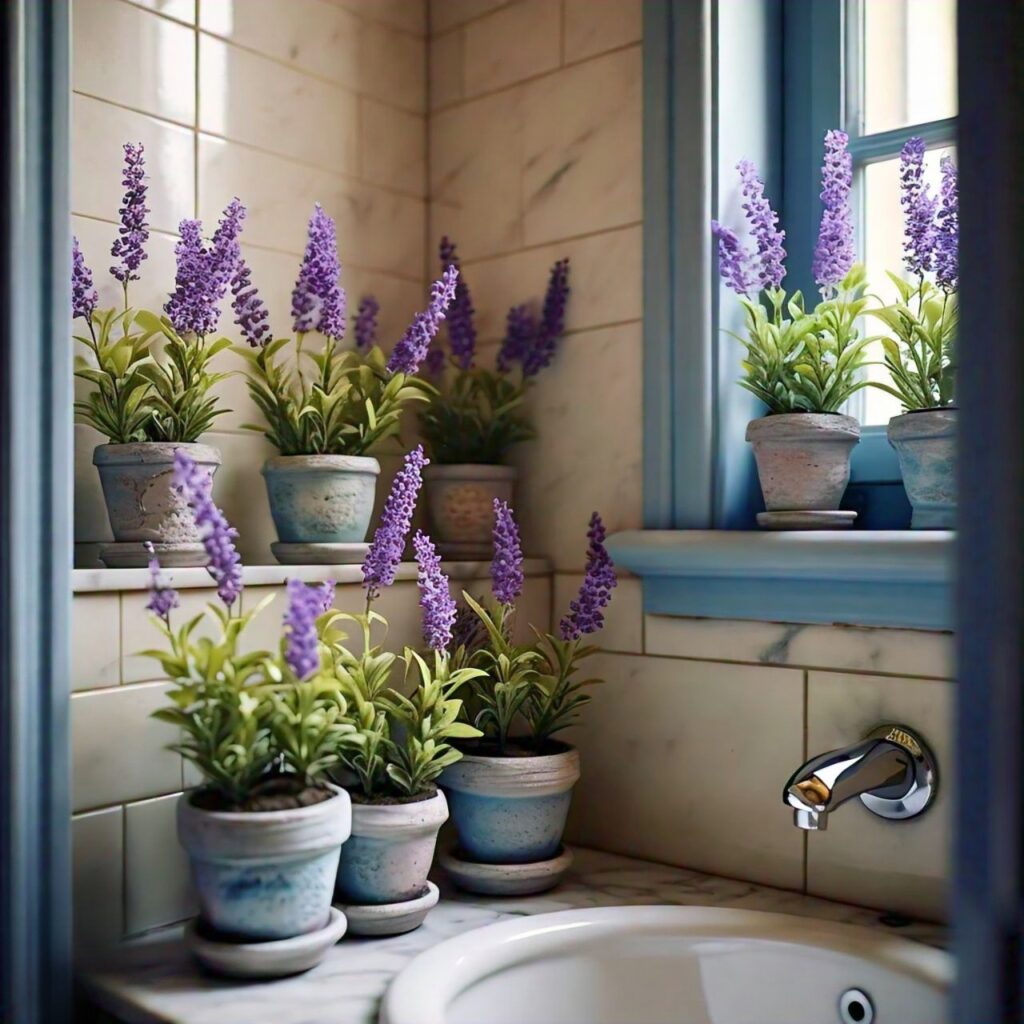
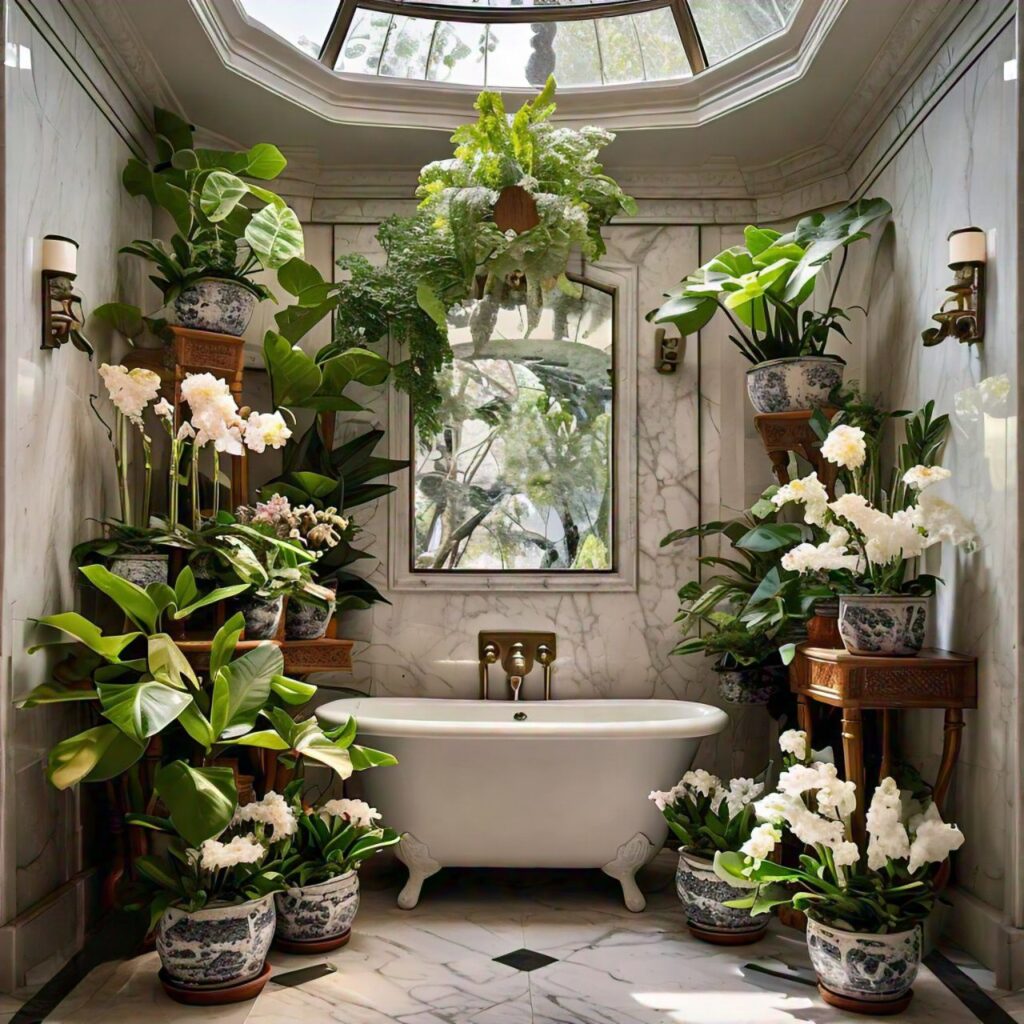
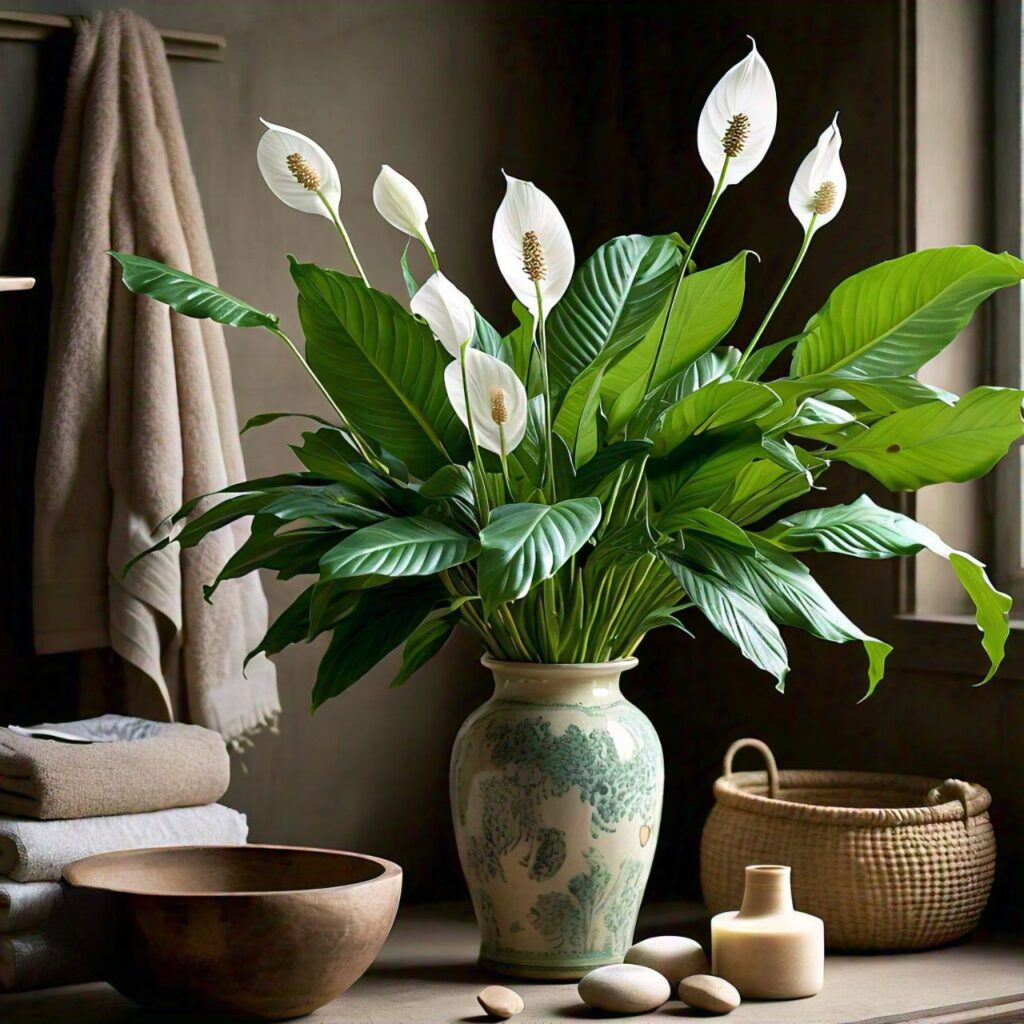
15. Reducing Bathroom Allergens:
Natural materials and plants in bathrooms can help reduce allergens and make it a healthier space. Use hypoallergenic plants like aloe vera in small bathrooms and non-toxic plants like spiders in medium spaces. Large washrooms can combine multiple natural materials and plants for the best results. Choose eco-friendly options like bamboo cabinets and hemp bath mats. Low-maintenance botanicals like the ZZ plant and sustainable botanicals also help make your bathroom more sustainable.
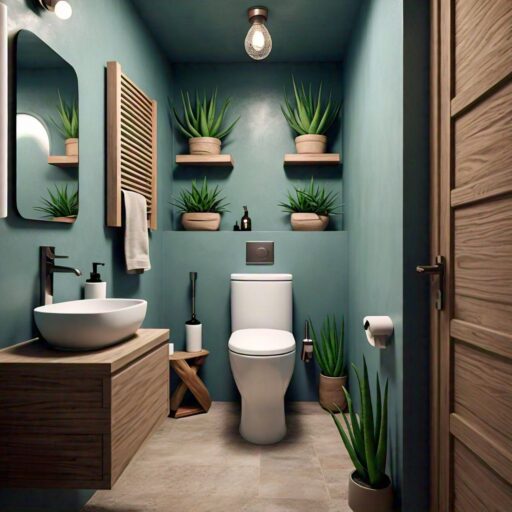

Conclusion:
Incorporating natural materials and plants in bathroom can not only make it look great but also make it healthier and more eco-friendly. Think about your bathroom’s specific needs when designing. In a small bathroom, use hanging baskets or wall-mounted planters to save space, and install a small vanity with marble or granite countertops. In larger spaces, you can use more materials and bigger plants.
This guide has shown you how to choose the best natural materials and plants in the bathroom. By using these ideas, you can create a peaceful and sustainable bathroom that’s good for you and the planet. Let nature inspire your next restroom renovation and make your bathroom a beautiful and healthy space.
FAQs:
1. How do I choose the right natural stone for my bathroom countertops?
When choosing natural stone for bathroom countertops, consider the durability and maintenance requirements. Granite is highly durable and resistant to stains, making it ideal for high-traffic areas. Marble offers elegance but requires regular sealing to prevent staining. Slate provides a textured finish and is slip-resistant, suitable for washroom floors.
2. Can bamboo cabinets withstand high humidity in bathrooms?
Yes, bamboo is naturally water-resistant and eco-friendly, making it an excellent choice for bathroom cabinets. However, ensure proper ventilation to prevent moisture buildup and prolong the lifespan of the bamboo.
3. How do I maintain a marble countertop in a bathroom?
To maintain a marble countertop, clean it regularly with a mild, pH-neutral cleaner to avoid etching. Seal the marble periodically to protect it from stains and water damage. Avoid placing acidic substances directly on the surface.
4. Are terracotta tiles suitable for wet bathroom areas?
Terracotta tiles are suitable for bathroom use, particularly in dry areas or as accent tiles. They should be sealed to prevent water absorption and staining. For wet areas, consider using glazed ceramic tiles, which are more water-resistant.
5. Which plants are best for low-light bathroom conditions?
Plants that thrive in low-light conditions include the peace lily, snake plant (Sansevieria), and ZZ plant (Zamioculcas zamiifolia). These plants are also low-maintenance and can tolerate high humidity, making them perfect for bathrooms with limited natural light.
6. How do I prevent mold growth on bathroom plants?
To prevent mold growth, ensure proper air circulation in the bathroom. Water wisely: let the soil dry slightly between waterings to keep plants happy and healthy. Choose plants like the snake and ZZ plant that can tolerate dry conditions.
To prevent mold growth, ensure proper air circulation in the bathroom. Water wisely: let the soil dry slightly between waterings to keep plants happy and healthy. Choose plants like the snake and ZZ plant that can tolerate dry conditions.
7. How do I integrate cork flooring into my bathroom design?
Cork flooring is sustainable and water-resistant, making it suitable for bathroom use. Install cork tiles with a water-resistant adhesive and seal the surface to protect against moisture. Cork provides a comfortable, slip-resistant surface ideal for restroom.
8. Which plants can help control bathroom humidity?
Plants like the Boston fern, calathea, and philodendron thrive in high humidity and can help regulate moisture levels in the bathroom. Place these plants in areas with indirect light and mist them regularly to maintain humidity.
9. How do I prevent water damage to wooden bathroom fixtures?
To prevent water damage, ensure all wooden bathroom fixtures, such as teak or reclaimed wood, are properly sealed. Regularly check and reseal the wood to maintain its water resistance. Use waterproof finishes and avoid prolonged exposure to standing water.
10. How do I incorporate plants in a small bathroom without cluttering the space?
In small bathrooms, use vertical space for plants. Hang spider plants or pothos from the ceiling or place them on shelves. Use small pots for countertops and window sills. Opt for compact restroom botanicals like aloe vera and air plants that require minimal space and care.
